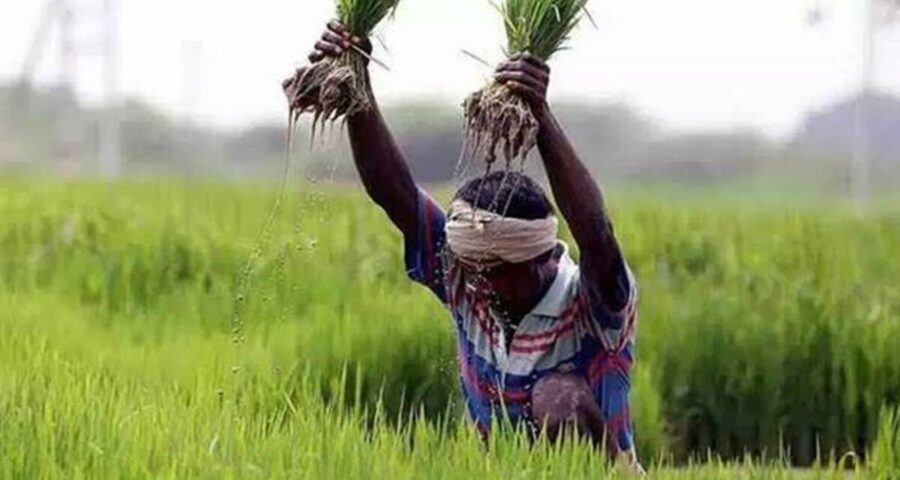More than 50 per cent of the increase in income was on account of higher monthly wages, which almost doubled to 4,063 in 2018 compared with Rs 2,071 in 2013.
The average outstanding loan per agricultural household increased 57.7 per cent to Rs 74,121 in 2018 compared with Rs 47,000 five years ago in 2013, according to the latest findings of a survey by the National Statistical Office.
The findings of the survey — Situation Assessment of Agricultural Households and Land Holdings of Households in Rural India, 2019 — released by the Ministry of Programme Implementation and Statistics on Friday also estimated that the average monthly income from different sources rose 59 per cent to Rs 10,218 based on the ‘paid out expenses’ approach in 2018-19 compared with Rs 6,426 in 2012-13. More than 50 per cent of the increase in income was on account of higher monthly wages, which almost doubled to 4,063 in 2018 compared with Rs 2,071 in 2013.
In the ‘paid out expenses’ approach, all out of pocket expenditure incurred for each type of input is taken into account. The agricultural year in India begins July and ends the following June.
The survey also revealed the number of agricultural households with outstanding loans at 4.67 crore during July-December 2018, about one lakh less than the 2013 estimate. The number of agricultural households was estimated at 9.30 crore during 2018-19.
During the survey, information was collected in two visits: July-December 2018 and January-June 2019. The data on outstanding loan was taken on the day information was collected from the household surveyed during the first visit.
The survey defines an agricultural household as one receiving more than Rs 4,000 as value of produce from agri activities (e.g., cultivation of field crops, horticultural crops, fodder crops, plantation, animal husbandry, poultry, fishery, piggery, bee-keeping, vermiculture, sericulture, etc.) and having at least one member self-employed in agriculture either in principal status or in subsidiary status during the last 365 days.
While the national average outstanding loan was Rs 74,121 during July-December 2018, it was the highest in Andhra Pradesh at Rs 2.45 lakh and lowest in Nagaland at Rs 1,750. Of the 28 states for which data is available, 11 states — Andhra Pradesh, Kerala, Punjab, Haryana, Telangana, Karnataka, Rajasthan, Tamil Nadu, Himachal Pradesh, Maharashtra and Madhya Pradesh — had higher average outstanding loan per household than the national average in 2018.
The average outstanding loan per agricultural household was over Rs 2 lakh in three states — Andhra Pradesh (Rs 2.45 lakh), Kerala (Rs 2.42 lakh) and Punjab (Rs 2.02 lakh); over Rs 1 lakh in five states — Haryana (Rs 1.82 lakh), Telangana (Rs 1.52 lakh), Karnataka (Rs 1.26 lakh), Rajasthan (Rs 1.13 lakh) and Tamil Nadu (Rs 1.06 lakh).
Between 2013 and 2018, the average outstanding loan per agricultural household has increased in the range of 13.52 per cent to 709 per cent across 25 states, while three states — Tamil Nadu (-8 per cent), Manipur (-9 per cent) and Arunachal Pradesh (34 per cent) — registered a decline.
In percentage terms, 16 states saw an increase higher than the national average of 57.7 per cent, with 10 of them registering an increase of over 100 per cent — Mizoram (709 per cent), Assam (382 per cent), Tripura (378 per cent), Sikkim (225 per cent), Himachal Pradesh (206 per cent), Nagaland (191 per cent), Jammu & Kashmir (149 per cent), Madhya Pradesh (131 per cent), Haryana (131 per cent) and Chhattisgarh (110.23 per cent).
Of the Rs 10,218 average monthly income (based on ‘paid out expenses’ approach) per agricultural household, Rs 4,063 came from wages; Rs 134 from leasing out of land; Rs 3,798 came as net receipt from crop production; Rs 1,582 as net receipt from farming of animals; and Rs 641 as net receipt from non-farm business.
The average monthly income based on the ‘paid out expenses and imputed expenses’ method per agricultural household was estimated at Rs 8,337 during 2018-19. In cases where no actual expenses were incurred by the household for any particular input (i.e., input used from home stock or from free collection, for example, seeds from own stock, self and unpaid family labour, owned animal and machine labour, etc.), ‘imputed expenses’ have been reported in the survey.
Of the Rs 8,337 average monthly income (based on ‘paid out expenses’ approach) per agricultural household, Rs 4,063 came from wages; Rs 134 from leasing out of land; Rs 3,058 as net receipt from crop production; Rs 441 as net receipt from farming of animals; and Rs 641 as net receipt from non-farm business.
Source: Read Full Article


